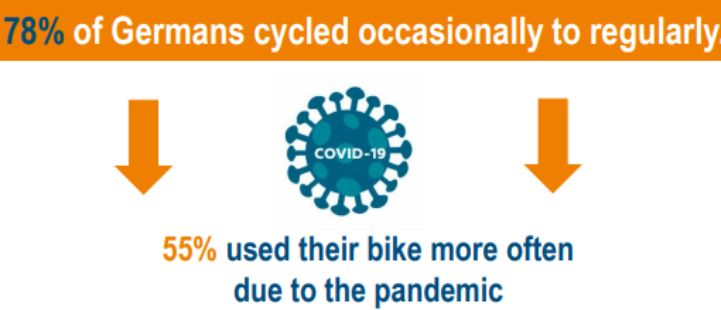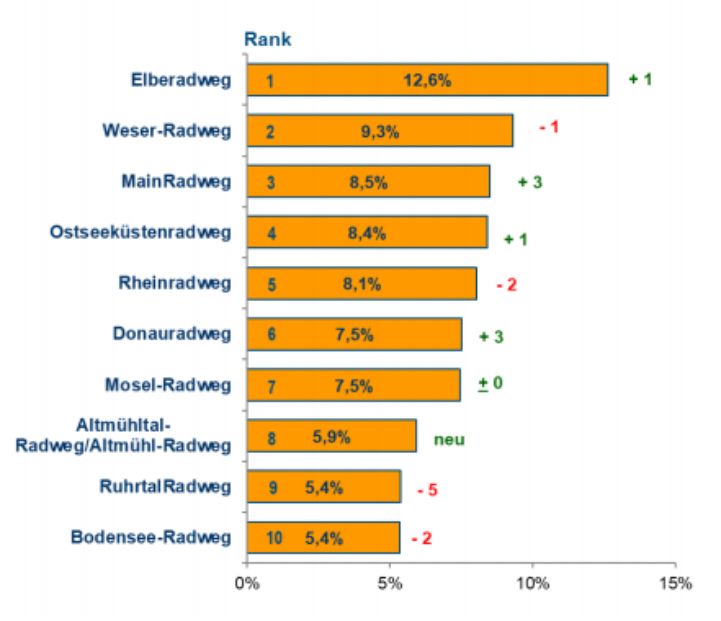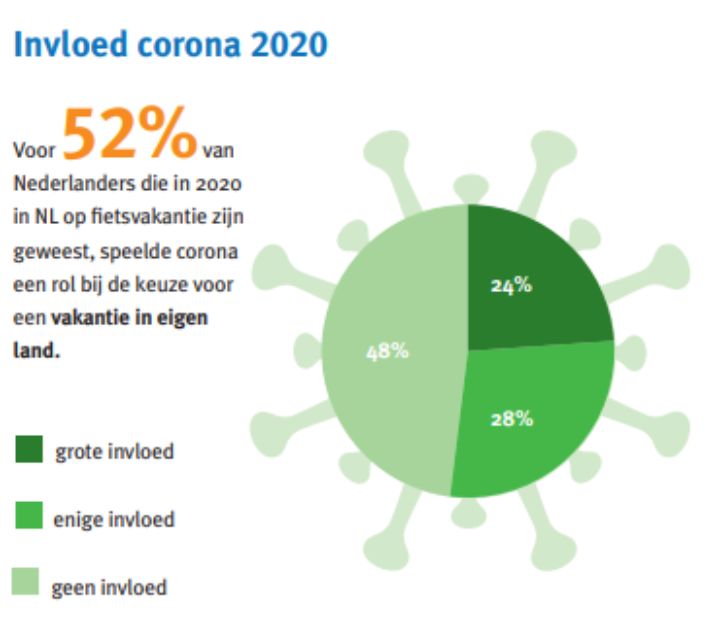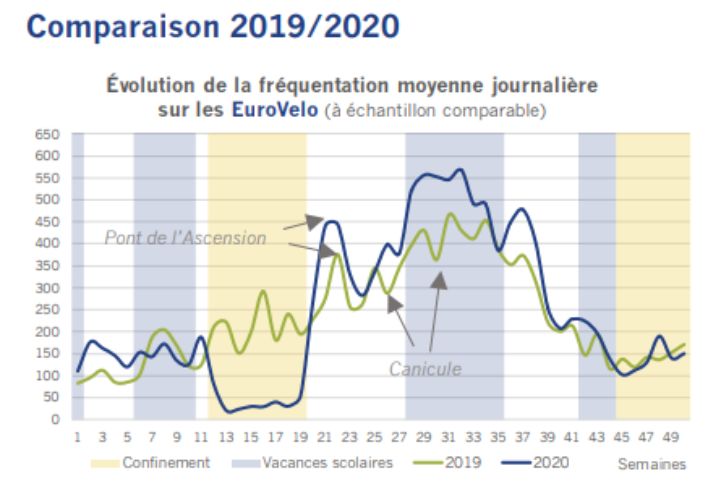Leisure Cycling grew last year in Germany, the Netherlands and France, proving that cycle touring is a safe and attractive option for many Europeans
Germany: More day trips and more frequent usage of EuroVelo routes
The German Cyclists’ Association ADFC presented its Bicycle Travel Analysis 2021, based on data extracted from the 22nd national survey on the bicycle travel market. This annual analysis provides some of the best available data on cycle tourism and, this latest edition, emphasizes the impact of Covid-19 on cycling frequency and volume levels.
The results indicate a change in travel behavior, with a notable shift towards cycle tourism during the pandemic. More than half of the respondents stated that the coronavirus pandemic resulted in them using their bicycle more often than usual. In 2020 a cycling trip was the main holiday of the year for 51% (2019: 35%) of respondents and 40% stated that last year’s cycling trip replaced a planned trip that had to be postponed or cancelled. Almost 90% of the participants in the survey undertook a domestic holiday, compared to the 81% of 2019. Only 1 out of 5 cycle tourists in Germany ventured to travel abroad, whereas the coronavirus pandemic played a role in their decision to remain in Germany in 2020.
An increase in cycling in general can also be observed in the Bicycle Travel for 2020 compared to 2019. 78% of Germans cycled occasionally to regularly, with the majority using their bicycle for daily journeys, followed by cycling day trips and holidays, and about a third for sport purposes. Most notably bicycle usage for sport purposes and day trips increased last year compared to 2019. A total of 464 million cycling day trips, that departed from home, were completed during leisure time compared to just 330 million in 2019. In addition, around 64 million cycling days trips were completed during a holiday away from the home (2019: 62 million).

The outlook for 2021 shows that even more people plan to go on a cycling holiday this year. More than half of those who traveled by bike in 2020 did so for the first time. Overall, 69% of all respondents – 18% more than in the previous year – expressed the desire to go on a cycling trip in 2021.
ADFC, again this year, listed the most popular long-distance cycle routes within Germany, with several of the itineraries overlapping the EuroVelo routes. The graphic below provides an overview of EuroVelo route usage measured within the analysis, many of which showed overall increases in usage: The “Elbe-Radweg” (Elbe Cycle Route) regained the lead in terms of Germany’s most cycled route. It builds part of the EuroVelo 4 – Central Europe Route and EuroVelo 7 – Sun route. The “MainRadweg” (Main-Cycle Route, EuroVelo 4 -Central Europe Route) moved up three places to third place (EuroVelo 4 -Central Europe Route) and the “Ostseeküsten-Radweg “(EuroVelo 10 - Baltic Sea Cycle Route) ranks fourth place. In the top ten reappears the “Rheinradweg” (EuroVelo 15 – Rhine Cycle Route) on fifth position, followed by the “Donauradweg” (Danube Cycle Path), which covers parts of EuroVelo 6 – Atlantic-Black Sea. It should be remembered that these are the results from within a total of 265 long-distance cycle routes in Germany. The increasing usage of EuroVelo routes documented by ADFC, are also reflected in data collected by Eco-Counter, with EuroVelo 4 being one of the most popular.

Some more highlights on cycle tourism undertaken in Germany in 2020 can be found in the report, such as: • The Internet was most commonly used when planning a cycling trip (76%), while during the journey signposting was the primary navigation tool for 67%. • The e-bike trend continues with 32% of the cycle tourists in 2020 using an e-bike (2019: 29%). • Austria, Italy and the Netherlands were the preferred destinations for Germans travelling abroad • 33% of the people, who used their bike on cycling vacations last year, also reported cycling more in the course of their day-to-day lives whilst 59% also used leisure routes for daily journeys such as commuting (+5%).
More information about the analysis and the route and region rankings can be found here, there is an English report available.
Notes: A cycle tourist is someone who has gone on at least one trip lasting at least three nights in the past three years during which cycling was one of the main motives. This includes point-to-point trips and regional trips through circular tours from a fixed base. Source: 2021 ADFC Bicycle Travel Analysis, from T.I.P. Biehl & Partner; ADFC.
Netherlands: More people choosing cycle touring for the first time to explore their country
The Dutch Cycling Association ‘Stichting Landelijk Fietsplatform’ has published a new cycle report that gives insight information on the effects of the pandemic on the 2020 cycling tourism season. Overall, the report shows a significant increase of people, who went on cycling vacations in 2020 in the Netherlands , with the average cycling holidaymaker being younger than in previous years, there were also more families with children travelling. As seen in the data, more than half (55.9%) of Dutch people, 16 years or over, enjoyed a cycling holiday in 2020, including bicycle tours, bicycle circular tours and cycling trips during a vacation.
More than half of the respondents declared that choosing a domestic vacation last summer was influenced by the COVID-19 pandemic to a greater or lesser degree.

The main reasons why the Dutch decided to cycle more were: More time for cycling due to less leisure activities available (58%). The positive effects that cycling has on health (53%) was also a reason influencing the Dutch to get on their bikes. About one third (32%) made a bicycle tour for the first time last year and around 11% did a cycle trip in the Netherlands for the first time, after previous experiences having been abroad. Six out of ten Dutch people who took a bicycle tour in the Netherlands in 2020 are planning to do so again in 2021 and another third are potentially planning on doing so.
More information about cycling holidays in 2020 in the Netherlands can be found in the publication Key Figures Cycling Holidays 2020-2021 and the accompanying factsheet.
Notes: Bicycle tour: Vacation in which one cycles from overnight address to overnight address and thus staying overnight at various places. (“point-to-point tours”) Bicycle circular tours: Vacation where one undertakes several cycling trips from a fixed vacation address.
Source: NBTC-NIPO, CVO 2019 and 2020 - April-Sept. Kien Onderzoek, Fietsvakanties en fietsstrektochten in Nederland, 2020. Nederland Fietsland cyclist panel, 'Cycling during corona', March- July 2020.
France: Many more trips on EuroVelo routes
Similar evidence of the 2020 cycling boom can also be found in the monthly monitoring by the French EuroVelo Coordination Center Vélo & Territoires. As seen in the graph below, an increase in cycling on the French EuroVelo routes can be observed, while taking into consideration variations caused by “Vacances scholars” (school holidays), “Pont de l’Ascension” (public holiday and extended weekend) and “Canicule” (heat waves) as well as the “Confinement” (lockdown). Over the year there was a general increase in route traffic volumes of +5% from 1 January to 13 December, or +22% excluding lockdown periods compared to 2019. After the lockdown, a significant rise could be seen especially on public holidays, school holidays (23%) and weekends (29%).

So far, in 2021, the number of bicycle journeys recorded continues to rise. Despite measures to limit travel, on average, from 1 January to 2 May, the usage of EuroVelo routes increased 23% in 2021 compared to the same period of 2019.
Source: This analysis is based on a national sample of 205 counters representative of all counters shared with the National Platform for Attendance (PNF). For more, check the Bike traffic volume in France reportwhich is updated on a monthly basis.
Cycling boom in the post-pandemic as an opportunity for cycling tourism
A glance at the data shows that people choose their bicycle especially for recreational and leisure purposes. It has proven to be the ideal solution for many to travel in a safe and healthy way, as it allows people to maintain distance while also being a boost for physical and mental health. Furthermore, the results indicate that more people went on a cycling holiday for the first time and that more chose to travel within their country, with many planning to do so again in 2021. Besides the promising numbers seen on these reports, many other European countries also experienced a cycling boom as a result of the pandemic and are continuing to enjoy a rising trend in cycling. As reported by ECF, data by Cycling Scotland has shown a 47% increase in cycling in Scotland from March 2020 to March 2021 compared to the previous year. Likewise in Austria, more people went cycling in 2020 for leisure and recreational purposes especially. Although, the results indicating the increase in cycling are positive, the crisis should also be seen as an opportunity for the tourism sector to reset some of its practices and to focus on a more sustainable future that promotes cycle tourism and leisure cycling. This can be done through including more provisions for cycling within the Post-Pandemic Recovery Plans.
Note that the data collection has been carried out differently from source to source and therefore cannot be compared. When reading the article it is important to keep in mind that lockdowns and restrictions on mobility were in place during the first and last months of 2020, which affected behavior in travelling and commuting.
Author: Antonia Tornow